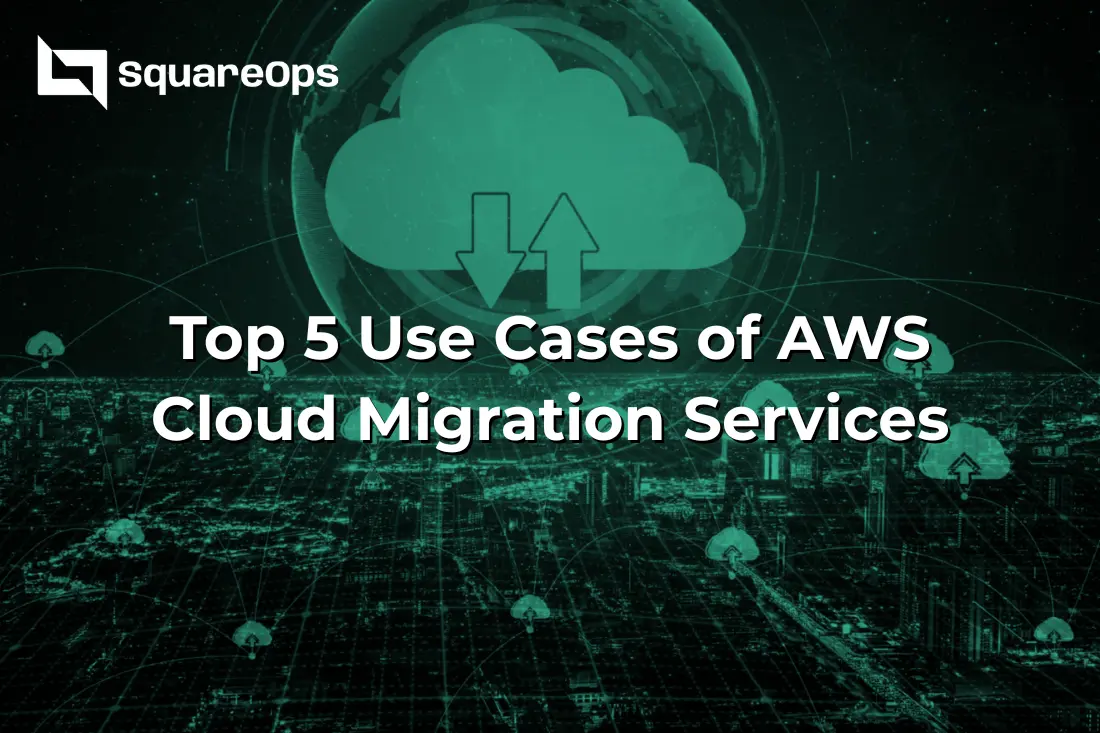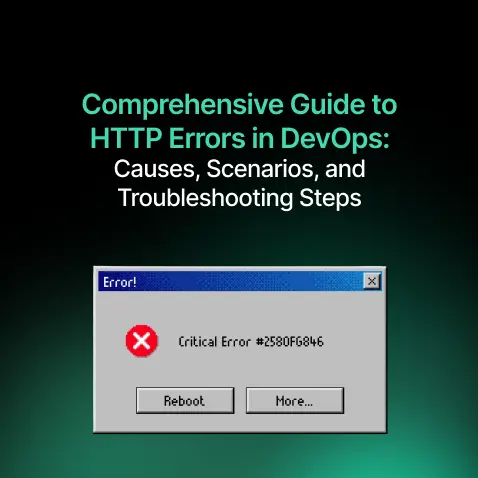Top 5 Use Cases of AWS Cloud Migration Services
- Nitin Yadav
- Knowledge
About

Explore the top 5 AWS Cloud Migration use cases that drive innovation, scalability, and cost-efficiency. Learn how businesses modernize with AWS in 2025.
Industries
- AWS, AWS cloud migration, AWS for Startups, CI/CD Pipelines, cloud hosting, Cloud Migration Services, Cloud Security, DevSecOps, Terraform
Share Via
As businesses increasingly adopt digital-first strategies, cloud migration has emerged as a critical component of enterprise IT transformation. Amazon Web Services (AWS), as a leading cloud provider, offers robust infrastructure and specialized services that enable seamless transitions from on-premise to cloud environments. AWS Cloud Migration Services help organizations modernize legacy systems, increase agility, reduce costs, and unlock innovation at scale. In this article, we explore the top 5 use cases of AWS Cloud Migration Services that are transforming industries.
What Are AWS Cloud Migration Services?
AWS Cloud Migration Services encompass a suite of tools and managed services that support the transition of applications, data, and workloads to the AWS cloud. These include:
- AWS Migration Hub: Centralized tracking of migrations across multiple AWS and partner solutions.
- AWS Application Migration Service (MGN): Automates lift-and-shift migrations.
- AWS Database Migration Service (DMS): Enables seamless migration of databases.
- AWS DataSync: Accelerates data transfers to AWS from on-premise or other cloud environments.
These services allow businesses to manage every phase of migration, from discovery and planning to execution and optimization.
Use Case 1: Legacy Data Center Modernization
Challenge
Traditional on-premise data centers are expensive to maintain, inflexible, and often lack the scalability required by modern applications.
AWS Solution
Organizations can migrate virtual machines, bare-metal servers, and monolithic applications to AWS using MGN. By leveraging EC2 instances, S3 storage, and managed databases like Amazon RDS, businesses can modernize infrastructure without completely rewriting their applications.
Real-World Impact
A global manufacturing company reduced infrastructure costs by 40% and improved application uptime by migrating its legacy ERP systems to AWS EC2 and RDS.
Use Case 2: Application Modernization for Startups
Challenge
Startups often build MVPs on monolithic stacks due to time constraints. As they grow, these architectures limit scalability and performance.
AWS Solution
AWS enables startups to replatform or refactor their applications during migration. Services such as:
- Amazon ECS or EKS for container orchestration
- AWS Lambda for serverless functions
- Amazon API Gateway for managing microservices
These services support application decoupling, improving performance and development velocity.
Real-World Impact
A SaaS startup scaled its user base 10x and reduced development time by 30% after refactoring its monolith into microservices on AWS.
Use Case 3: Disaster Recovery and High Availability
Challenge
Maintaining an on-premise disaster recovery (DR) site is costly and complex. Downtime during outages can severely impact business continuity.
AWS Solution
With AWS, organizations can build cost-effective DR strategies using:
- Amazon S3 and Glacier for backup
- Amazon RDS Multi-AZ for database failover
- AWS CloudFormation for automated recovery
- Route 53 for traffic routing
Real-World Impact
A healthcare provider ensured 99.99% uptime by implementing an active-passive DR strategy across AWS regions, enabling rapid failover with minimal data loss.
Use Case 4: Scalable Web Application Hosting
Challenge
E-commerce platforms, media sites, and SaaS apps face unpredictable traffic spikes that can overwhelm traditional servers.
AWS Solution
Migrating web apps to AWS allows for:
- Auto-scaling with Amazon EC2 Auto Scaling
- Global content delivery with Amazon CloudFront
- Application-level monitoring via AWS CloudWatch
- Load balancing with Elastic Load Balancer (ELB)
Real-World Impact
A fashion eCommerce brand reduced page load times by 50% and scaled effortlessly during holiday sales using EC2 Auto Scaling and CloudFront.
Use Case 5: Big Data and Analytics Workloads
Challenge
On-premise analytics solutions are not scalable and require significant hardware investments.
AWS Solution
AWS provides a rich set of analytics and AI/ML services:
- Amazon Redshift for data warehousing
- AWS Glue for ETL workflows
- Amazon Athena for querying S3 data
- Amazon Kinesis for real-time streaming
- Amazon QuickSight for BI dashboards
Real-World Impact
A fintech company improved its fraud detection capabilities and reduced query latency by 70% after migrating analytics workloads to AWS Redshift and Kinesis.
Common Migration Strategies
AWS supports several migration strategies tailored to different business goals:
- Rehost (Lift & Shift): Move apps as-is to the cloud
- Replatform: Optimize infrastructure with minimal changes
- Refactor: Redesign apps for cloud-native environments
- Repurchase: Replace with SaaS
- Retire: Decommission obsolete systems
- Retain: Keep workloads on-premise temporarily
Benefits of Using AWS for Cloud Migration
- Speed and Agility: Faster provisioning and deployment
- Cost Optimization: Pay-as-you-go pricing with auto-scaling
- Security: In-built compliance and security controls
- Innovation Enablement: Access to AI, ML, IoT, and analytics services
- Global Reach: Deploy workloads in multiple regions for low latency
How to Get Started
- Assessment: Use AWS Migration Readiness Assessment (MRA)
- Planning: Define success metrics and prioritize workloads
- POC: Pilot migration with a non-critical workload
- Execution: Use AWS Migration tools
- Optimization: Implement cost control and monitoring
Conclusion
AWS Cloud Migration Services empower businesses to evolve faster by eliminating the constraints of legacy systems. Whether you’re modernizing infrastructure, enabling disaster recovery, or scaling web apps, AWS offers flexible, secure, and cost-efficient solutions for every use case. As digital transformation accelerates across industries, migrating to AWS is not just a technical upgrade—it’s a strategic enabler for innovation and growth
Contact SquareOps Today for a Seamless Cloud Migration
Frequently asked questions
AWS Cloud Migration Services help organizations move their IT infrastructure, applications, and data from on-premise or legacy systems to AWS cloud environments, ensuring a smooth, secure, and cost-effective transition.
AWS provides scalability, flexibility, cost savings, and extensive tools for cloud migrations. It supports various migration strategies such as lift-and-shift, replatforming, and refactoring, making it a versatile choice for organizations of all sizes.
The time required for AWS cloud migration depends on the complexity of the workload, the size of the infrastructure, and the chosen migration strategy. Simple migrations may take a few weeks, while complex ones can span months.
Benefits include cost efficiency, improved scalability, increased performance, enhanced security, and faster time-to-market for new products and services. AWS also offers robust compliance features for various industries.
Workloads such as legacy applications, databases, data storage systems, web applications, and business critical applications can be migrated to AWS. AWS provides a variety of services to support these migrations.
The AWS Migration Hub is a service that helps you track the progress of your migration across multiple AWS and partner tools. It simplifies managing and monitoring migration tasks from a single dashboard.
AWS uses robust encryption, identity and access management (IAM), and compliance tools to ensure data is secure during migration. These services protect sensitive information both in transit and at rest.
The right strategy depends on your organization’s goals and current IT setup. You can choose between rehosting (lift-and-shift), replatforming, refactoring, or repurchasing based on your needs and future scalability.
Yes, AWS supports disaster recovery through services like AWS Backup, Multi-AZ deployments, and cross-region replication, ensuring business continuity during the migration process.
Start by evaluating your current infrastructure, identifying key workloads for migration, and using tools like AWS Migration Hub. Engage AWS consultants or partners if necessary, to build a migration roadmap tailored to your business.
Related Posts

Comprehensive Guide to HTTP Errors in DevOps: Causes, Scenarios, and Troubleshooting Steps
- Blog

Trivy: The Ultimate Open-Source Tool for Container Vulnerability Scanning and SBOM Generation
- Blog

Prometheus and Grafana Explained: Monitoring and Visualizing Kubernetes Metrics Like a Pro
- Blog

CI/CD Pipeline Failures Explained: Key Debugging Techniques to Resolve Build and Deployment Issues
- Blog

DevSecOps in Action: A Complete Guide to Secure CI/CD Workflows
- Blog

AWS WAF Explained: Protect Your APIs with Smart Rate Limiting
- Blog

